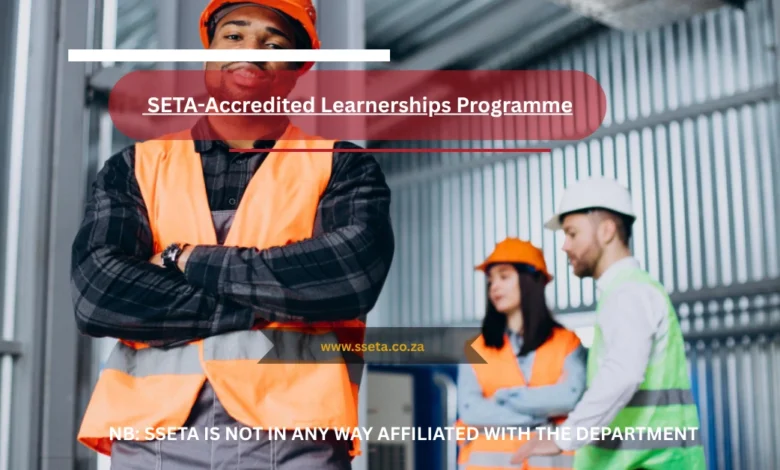Your Pathway to Skills and Success: A Complete Guide to SETA-Accredited Learnerships Programme

Opening the Door to New Possibilities
In every career journey, there’s a moment when you know it’s time to grow—whether you’re finishing school, changing careers, or seeking advancement. That’s where learnerships come in. More than just training programmes, SETA-accredited learnerships Programme offer a powerful bridge between education and real-world employment.
But how do you find these opportunities? How can you tell what’s legitimate, and how do you stand out when you apply?
This guide is your roadmap—unfolding step-by-step how to find, verify, and apply for SETA-accredited learnerships Programme in South Africa. Whether you’re just getting started or looking to build on existing experience, you’re in the right place.
Understanding the Foundation: What Is SETA?
The Role of SETA in Shaping South Africa’s Workforce
SETA stands for Sector Education and Training Authority. These authorities were established by the South African government to ensure that skills development aligns with industry needs across sectors like construction, IT, finance, healthcare, and more.
When a learnership is SETA-accredited, it means the training provider has been evaluated and approved to deliver quality education that meets national standards. This kind of endorsement helps ensure that your learning leads to employability—not just a certificate.
Why SETA Accreditation Matters
Choosing a SETA-accredited programme means:
- Credibility: Your training is recognized nationwide.
- Funding Access: Many programmes are subsidized by the government.
- Better Job Prospects: Employers value accredited training.
- Real Experience: Learnerships include both classroom learning and on-the-job training.
Learnerships That Fit Your Future
Types of Programmes You Can Pursue
SETA oversees multiple sectors, each offering different learnership options. Whether you’re passionate about numbers, people, technology, or hands-on work, there’s likely a match for you.
Some popular fields include:
- Information Technology (IT)
- Engineering and Manufacturing
- Finance and Business Administration
- Healthcare and Social Services
- Construction and Infrastructure Development
Programmes typically range from 6 to 12 months and include a mix of theoretical learning and workplace application.
Matching Your Career Goals to the Right Learnership
When selecting a programme, reflect on:
- Your long-term career interests
- Your current qualifications
- Industries that are hiring in your area
Choosing the right fit means greater satisfaction and higher chances of long-term success.
Where to Begin: Finding Accredited Learnerships
1. Start with the Official SETA Channels
Each SETA has its own website with updated listings of accredited training providers and available learnerships. Use filters like sector or province to narrow your search.
Helpful resources:
- National SETA Portal
- Individual SETA websites (e.g., MERSETA, SERVICES SETA, HWSETA)
You can also subscribe to alerts or newsletters to stay informed.
2. Browse Trusted Job Portals
Well-known South African job platforms regularly advertise learnerships:
Set up email alerts using keywords like “SETA learnership” and “accredited training.”
3. Use Your Network and Local Resources
Not all opportunities are posted online. Some are shared through:
- Industry events and expos
- Trade unions and professional associations
- Local NGOs and community job centres
Be proactive—ask around, attend events, and stay visible.
4. Speak with Career Counselors or Advisors
If you’re in school or recently graduated, speak to your school counselor. They can recommend accredited programmes and help prepare your documents. Many tertiary institutions also partner with SETA-accredited providers.
Check Before You Commit: Verifying Accreditation
How to Know If a Programme Is Legitimate
Before applying to any learnership, always verify the programme’s accreditation.
Here’s how:
- APPLICATION PROCESS relevant to your chosen field.
- Search for the training provider’s name on the list of accredited institutions.
- Request a copy of the accreditation certificate if it’s not posted online.
Don’t rely solely on promotional material or verbal assurances.
Warning Signs of a Scam
Be cautious if a programme:
- Can’t provide proof of SETA accreditation
- Uses a poorly designed or vague website
- Asks for large upfront payments without documentation
- Promises guaranteed employment with no interviews or assessments
If something doesn’t feel right, it probably isn’t. Contact SETA directly if you’re unsure.
Ready to Apply? Here’s What You Need to Do
Get Your Documents in Order
Most programmes require the following:
- A clear, updated Curriculum Vitae (CV)
- Certified copy of your South African ID
- Copies of qualifications or latest school report
- A well-written motivation letter
Scan your documents for digital applications, and keep printed copies ready for in-person submissions.
Writing a Motivation Letter That Tells Your Story
This is your chance to stand out. Your letter should answer:
- Why are you applying for this learnership?
- What skills or experiences do you bring?
- How does this opportunity align with your career goals?
Tip: Personal stories matter. If you’ve faced challenges or have a unique passion, share it.
Following the Process Step-by-Step
Always:
- Read the entire application form before filling it out.
- Follow submission instructions exactly (e.g., email subject lines, formats).
- Meet the deadline—early submissions are ideal.
Incomplete or rushed applications often don’t get considered.
Acing the Next Step: Interviews and Assessments
Be Prepared and Professional
If your application is shortlisted, you might be invited to:
- Attend an interview (in-person or virtual)
- Complete a skills or literacy assessment
- Join a group discussion or workshop
Tips for success:
- Dress neatly, even for virtual interviews.
- Practice common questions, such as your strengths, goals, and interests.
- Stay calm, and be honest about your experience.
Employers are looking for learners who are motivated, open to learning, and committed to growing.
Making the Most of Your Learnership
Learnerships Are More Than a Job—They’re a Launchpad
Once you’re accepted, here’s how to stand out:
- Be punctual and reliable
- Take notes and ask questions
- Volunteer for extra tasks when possible
- Build positive relationships with mentors and colleagues
Your performance can lead to future job offers or references.
Do you wish to compete in Seta-accerdited learnerships programme?
- Read all instructions carefully.
- Pay attention to deadlines and preferred submission methods—online forms, email, or in person.
- Fill out forms completely and honestly for SETA upcoming opportunities
- Poorly filled applications are often rejected outright.
What Happens After the Learnership?
Many SETA-accredited programmes end with a recognised qualification and sometimes even a job offer.
Even if you don’t stay with the same company:
- Your CV now includes both skills and experience
- You’ve expanded your professional network
- You’re better positioned for future roles or studies
Staying Ahead: Resources to Keep You Informed
Never Miss an Opportunity
Use these tools to stay updated:
- Job site alerts for “learnership” and “SETA-accredited”
- Newsletters from career development organisations
- Social media pages of SETAs and industry groups
Consistency is key—check weekly and follow up on your applications.
Where to Get Help If You’re Stuck
If you’re unsure where to go next:
- Visit a Department of Labour centre
- Contact the relevant SETA
- Speak with a career advisor or employment centre
You don’t have to do this alone—support is available if you ask.
Your Journey Starts Now
Finding and applying for a SETA-accredited learnership might seem overwhelming at first. But step by step, with the right approach, it becomes manageable—and even exciting.
This process is about more than finding work. It’s about building a future you can be proud of.
So take that first step:
- Explore your interests
- Research accredited opportunities
- Prepare your documents
- Apply with confidence
- And most importantly—stay persistent
Every expert once started as a learner. Your future starts here.




